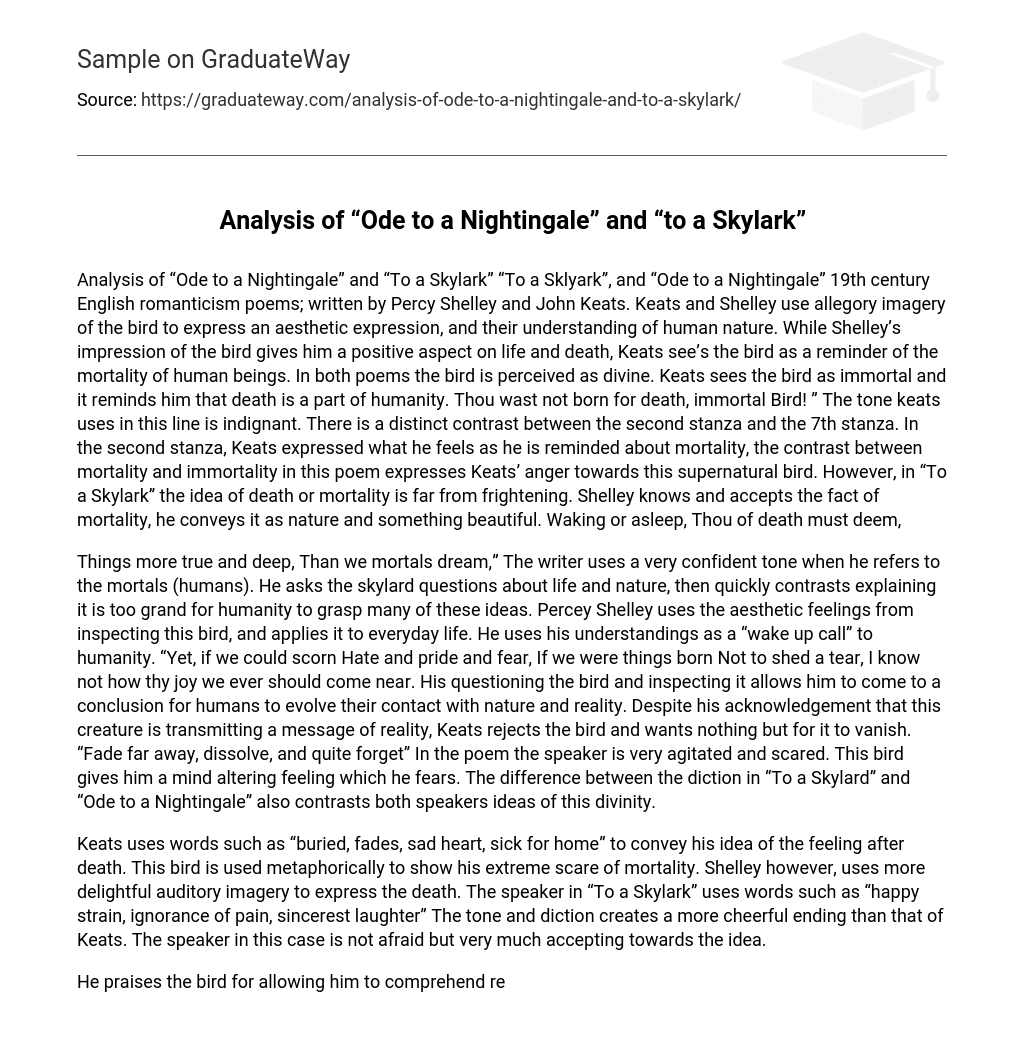Analysis of “Ode to a Nightingale” and “To a Skylark” “To a Sklyark”, and “Ode to a Nightingale” 19th century English romanticism poems; written by Percy Shelley and John Keats. Keats and Shelley use allegory imagery of the bird to express an aesthetic expression, and their understanding of human nature. While Shelley’s impression of the bird gives him a positive aspect on life and death, Keats see’s the bird as a reminder of the mortality of human beings. In both poems the bird is perceived as divine. Keats sees the bird as immortal and it reminds him that death is a part of humanity. Thou wast not born for death, immortal Bird! ” The tone keats uses in this line is indignant. There is a distinct contrast between the second stanza and the 7th stanza. In the second stanza, Keats expressed what he feels as he is reminded about mortality, the contrast between mortality and immortality in this poem expresses Keats’ anger towards this supernatural bird. However, in “To a Skylark” the idea of death or mortality is far from frightening. Shelley knows and accepts the fact of mortality, he conveys it as nature and something beautiful. Waking or asleep, Thou of death must deem,
Things more true and deep, Than we mortals dream,” The writer uses a very confident tone when he refers to the mortals (humans). He asks the skylard questions about life and nature, then quickly contrasts explaining it is too grand for humanity to grasp many of these ideas. Percey Shelley uses the aesthetic feelings from inspecting this bird, and applies it to everyday life. He uses his understandings as a “wake up call” to humanity. “Yet, if we could scorn Hate and pride and fear, If we were things born Not to shed a tear, I know not how thy joy we ever should come near. His questioning the bird and inspecting it allows him to come to a conclusion for humans to evolve their contact with nature and reality. Despite his acknowledgement that this creature is transmitting a message of reality, Keats rejects the bird and wants nothing but for it to vanish. “Fade far away, dissolve, and quite forget” In the poem the speaker is very agitated and scared. This bird gives him a mind altering feeling which he fears. The difference between the diction in “To a Skylard” and “Ode to a Nightingale” also contrasts both speakers ideas of this divinity.
Keats uses words such as “buried, fades, sad heart, sick for home” to convey his idea of the feeling after death. This bird is used metaphorically to show his extreme scare of mortality. Shelley however, uses more delightful auditory imagery to express the death. The speaker in “To a Skylark” uses words such as “happy strain, ignorance of pain, sincerest laughter” The tone and diction creates a more cheerful ending than that of Keats. The speaker in this case is not afraid but very much accepting towards the idea.
He praises the bird for allowing him to comprehend reality. Where as the speaker in “Ode to a Nightingale” resents the bird for influencing him with reality. Both authors use the allegory imagery of a bird to describe the mortality of human beings. However, through their use of metaphors, imagery and expression their ideas are very contrasted. Shelley enjoys the aesthetical pleasing of the bird as well as the spiritual one. Keats contrasts this idea by being afraid to face reality and uses dark imagery to describe mortality and the feeling after life.





